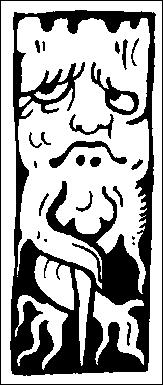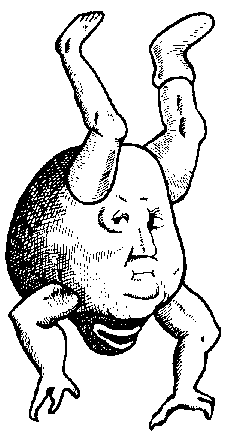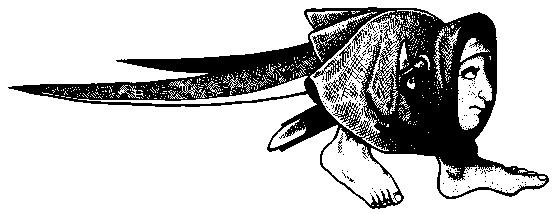Ogre
Michel Tournier
Translated by
Barbara Bray
(Johns Hopkins)
 The novel was not invented in England by the likes of Fielding, DeFoe, or Richardson --- but in the 16th century by an anonymous Spanish nobleman. The novel --- more exactly, the picaresque novel --- came into being with La Vida de Lazarillo de Tormes. Picaresque writing is, as one dictionary has it, "a type of fiction dealing with the episodic adventures of a usually roguish protagonist." On The Road is picaresque, as is Catcher in the Rye. Tropic of Cancer probably is too, as are some of Norman Mailer's early fictions. (We can even stretch the definition to suggest that In Cold Blood might be of the same category, along with some of Nathaniel West's novels, and perhaps even Lolita.)
The novel was not invented in England by the likes of Fielding, DeFoe, or Richardson --- but in the 16th century by an anonymous Spanish nobleman. The novel --- more exactly, the picaresque novel --- came into being with La Vida de Lazarillo de Tormes. Picaresque writing is, as one dictionary has it, "a type of fiction dealing with the episodic adventures of a usually roguish protagonist." On The Road is picaresque, as is Catcher in the Rye. Tropic of Cancer probably is too, as are some of Norman Mailer's early fictions. (We can even stretch the definition to suggest that In Cold Blood might be of the same category, along with some of Nathaniel West's novels, and perhaps even Lolita.)The Ogre is very much a part of the genre. A very roguish hero, meeting with other rogues, in episodic adventures. But Tournier has created something far more subtle and fascinating than Tropic of Cancer or On the Road. True: it's a rouge's tale, along with a huge castle of fact and fancy, forming a bizarre whole, but with the craft of Tournier's words, we would suggest that he has bested the genre, giving us a strange story which could only come out of the mid-twentieth century.
For a worthy novel --- picaresque or no --- has to come on us from many directions. It has to lasso us with its style; it has to interest us in its characters. It has to teach us something, about people, about things. And, if the author knows what he or she is doing, it has to pull us in with symbols, themes, messages, interstices, and parallels. The Ogre does all these --- and more. Tiffuages, the hero, avid learner as he is, becomes an expert on various subjects --- and in the process, we, too, become experts. On such unlikely subjects as homing pigeons, the antlers of stags, animal scat, Prussian mythology, the origin of the concept of "phoric" (to bear), St. Christopher, twins, Abel and Cain, and, finally, Nazism and the Hitler Youth.
Like it's hero, The Ogre is an eccentric mix, but the author manages to bring it all off. For instance --- listen to this on pigeons,
- Tiffauges was looking with some uneasiness at this partly exotic, partly monstrous collection when he noticed, huddled against a box, a perfectly ovoid heap of reddish feathers, its head and legs invisible. He went over to it curiously and stretched out his hand. The egg immediately disintegrated into two magnificent pigeons, the color of dead leaves and perfectly identical. Tiffauges got hold of them both at once and examined them with a connoisseur's eye, looking in vain for a detail that might distinguish one from the other....
He stood with a pigeon in each hand, putting them together and setting them apart like the two halves of one simple harmonious object that has been accidentally broken. Every time the two russet brothers touched, they formed an egg by an automatic reflex that intermingled all their parts. It was as if they were drawn and held together buy a magnetic force...
Twins. "Benign inversion." As a good novelist must, Tournier plants the seeds, at the very beginning, of the twins in all of humanity, good and evil, where "right becomes left, left becomes right, good is called evil and evil is called good." This theme of twins pops up again and again in The Ogre in the pigeons, in the reversals of coats-of-arms (the bastard side), in elk: The chief forester, standing apart with Tiffauges, explained that an injury to a testicle from a bullet or barbed wire, or a wound from the antlers of another deer, or a congenital malformation, always produces some defect or strangeness in the antler on the opposite side.
Later, on the faces of twins:
- ...the left and right halves, though they may be very alike on the whole, still present innumerable small discrepancies...the left turned toward the past, reflection and emotion, the right toward the future, action and aggression, and the two stuck together at the last stage of creation...
 In Kaltenborn, the Youth Camp, during the disintegration of the Third Reich, we find Tiffauges, this unlikely Frenchman who is exactly contrary to the Nazi ideal of beauty --- thin, pale, ugly, thick glasses, "microgenitomorphus" (his girl-friend said he made love like a "canary") --- left in charge of 400 boys. He is sent out, paradoxically, to capture more boys for the camp. He finds Haro and Hajo,
In Kaltenborn, the Youth Camp, during the disintegration of the Third Reich, we find Tiffauges, this unlikely Frenchman who is exactly contrary to the Nazi ideal of beauty --- thin, pale, ugly, thick glasses, "microgenitomorphus" (his girl-friend said he made love like a "canary") --- left in charge of 400 boys. He is sent out, paradoxically, to capture more boys for the camp. He finds Haro and Hajo,
- mirror twins who can be superimposed on one another face to face, not one on top of the other....It is no longer a matter of a contradictory tumult in which souls neutralize one another. The two bodies really have only one concept between them with which to clothe themselves in intelligence and fill themselves with spirit, So they develop with calm indecency, exhibiting their creamy complexion, their pink down, their muscular or adipose tissue in an animal nudity that is unsurpassable. For nudity is not a state but a quantity and as such infinite in theory, limited in fact.
The Ogre is of complex structure. As with the novels of Thomas Mann, or Umberto Ecco, it takes a while to crank up, the machinery is finely tuned but it takes a bit before it gets going. Part I --- all in the first person --- is filled with some sputterings and wheezes --- but by page 130 or so, the machinery is running along as a humming artistic whole. In the process, it gives us some rich thoughts to stay with us after we have finished:
- Every man must throughout his life have an "essential age" that he aspires to till he reaches it and clings to after he's passed it.
The absolute power of a tyrant always ends by driving him mad...Nothing is harder to endure than the imbalance between infinite power and limited knowledge.
There's probably nothing more moving in a man's life than the accidental discovery of his own perversion.
